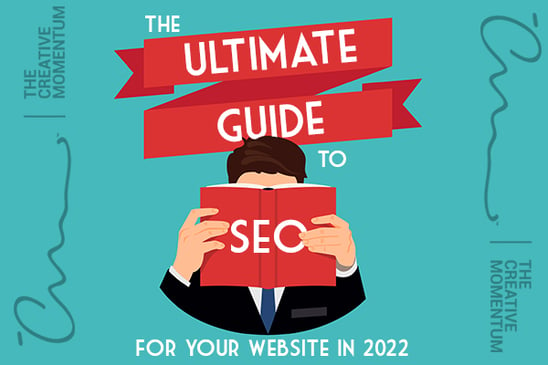
We all know that no matter how beautiful or functional your website is, it's all for nothing if you can’t drive traffic to it. This is more true in 2022 than ever before when you consider just how much competition is out there these days in organic search.
If people can’t organically find your site, or if you've noticed your ranking dropping and find yourself scratching your head and wondering why this is happening, it's time to revisit a core tenant of your marketing: applying cutting-edge search engine optimization (SEO) tactics to boost visibility and improve your Google search page ranking.
While SEO should be an "always on" task, it’s never too late to course-correct and develop a website that’s not only physically beautiful and user-friendly, but also leverages key SEO principles that'll help you rank higher in search (on a Google search page).
The trick is that the SEO landscape in 2022 looks a lot different than it used to, and companies need to stay ahead of the curve if they want to see results. The following article will help you do just that.
SEO Methodologies Explained: On-Page and Off-Page SEO
At its most basic, SEO in 2022 is the same beast we know and love. It simply refers to tactics and strategies that allow search crawlers from sites like Google, Bing and others to find your content and add you to the search engine results pages (SERPs). And depending on the effectiveness of your SEO strategy, as well as how effectively you implemented technical SEO strategies, your content will either appear higher or lower in those organic search results.
And to do this properly, you need to implement on-page and off-page SEO in conjunction with technical SEO elements. Once you know the difference between these methodologies, you can create a better SEO implementation strategy, delegate tasks to the right team members, and regularly maintain it.
On-Page SEO Defined
On-page SEO is composed of strategies that you directly manage on your website. This includes activities on your website’s backend as well as the content users view and interact with on your website. On-page SEO can include:
- HTML code optimization
- Compelling and relevant content
- Proper target keywords and implementation
- Proper metadata formatting to improve search visibility
As long as you (or your web developer) can control the formatting or implementation with the results either visible on your website or directed towards your website, it’s considered on-page SEO. Well-managed on-page SEO enhances your organic search engine results page ( SERP ) ranking and remains one of the most important SEO tactics to implement in 2022.
Off-Page SEO Defined
Unlike on-page SEO, off-page SEO covers other activities that can impact discoverability and organic search rank, but that isn’t directly controlled by you. For example, backlinks from media outlets, customer reviews on aggregate platforms like Yelp, and even social media all fit within this category. Off-page SEO can boost your overall reputation with target audiences by proving relevance and giving you social currency.
All of the above are factors that are important but that you can’t immediately control. You can’t control customer reviews on third-party websites or manipulate social media SEO either. And with backlinks, you don’t always control which websites link back to you. While backlinks are amazing when they’re coming from authoritative websites, a spammy website linking back to your business will hurt your rank. Keep these issues in mind as you refine your SEO tactics.
Technical SEO Tactics
We'll review a few of the top on/off-page SEO strategies for 2022 below, but first, let's dig into a few essential technical SEO elements.
The Importance of the Anatomy of the SERP
SEO in 2022 looks a lot different than it used to, and nowhere is this better exemplified than in the way SERPs reflect the user's intent in organic search queries.
In the early days of SEO, it used to be enough to optimize your content for organic search. In those days, the SERPs were limited to a set of links and nothing more – bare bones compared to what we have today.
Modern SERPs are presented differently – as in literally visually different – that take the user experience to the next level depending on what was searched. Different SERP components include:
- Organic search results
- Google My Business directory listings
- PPC/Paid Ad results
- Featured Snippets
- Knowledge Panels
- Local Packs
- Video/Images
Companies need to keep this in mind with their SEO efforts. Mastery over on/off-page SEO doesn’t cut it. You need to understand user intent and what exactly users are hoping to find when searching for you and viewing a Google search page. For example, if a user needs a local plumber or other contractor, they're more likely to be served a local trust pack result or Google My Business directory listing. If a user searches for a well-known persona or company, there's a good chance they'll be served a knowledge panel.
 An example of a knowledge panel found on a Google search page
An example of a knowledge panel found on a Google search page
When you keep searcher intent in mind, you can improve your SEO by creating content that targets those types of short and long-tail keywords, improving your chances of earning a spot within these highlighted resources, ensuring that your name gets out there even if you aren’t the highest organic search result.
Create High-Value Pillar Pages
Another SEO trend that has emerged over the past few years is pillar content. This tactic requires some coordination among your marketing teams in terms of planning out a long-term content strategy, but it can pay big dividends.
The idea is that your pillar content (also called a pillar page) forms the foundation for a specific content topic, acting as a kind of all-in-one resource for the subject.
For example, you may have an extensive content library on SEO-related topics. Pillar pages act as a type of long-form hub (often 2,000 words or more) that provide a primary overview of the SEO topic, including outbound links to each subtopic you’ve written. Here, this may include Inbound Marketing SEO, On-Page SEO, Technical SEO, and so on.
This format has three components:
- Pillar Content: The pillar page itself that works as a “hub” for all related topics
- Cluster Content: The additional resources or subtopics that branch off your pillar topic
- Hyperlinks: How you connect the above content types
There are multiple advantages to pillar content, both from a user and technical standpoint. On the user side, pillar pages provide great resources where users can easily access any and all information you’ve written on a given topic.
On the technical side, pillar pages are a way of structuring your website pages to become easier for search engines to "understand," or index appropriately in organic search results. Under traditional page indexing, search crawlers find content, review the metadata, and categorize the page in a database until it needs to be pulled. Pages rank based on the strength of their keyword strategy and format. Straightforward enough.
The problem is that this type of conventional indexing is a disorganized strategy with little connection between topics. Sites are indexed haphazardly, and if you’ve written multiple posts on the same topic, those pages may compete against each other for SERP rankings. Think of a file cabinet: it's much easier to find what you're looking for when all of the papers are filed in the appropriate folders, but if everything is thrown into the cabinet with post-it notes signifying their topics, it becomes difficult to find what you're looking for.
Pillar pages focus on one broad topic with keyword optimization reserved for each piece of cluster content. This ensures that your pages don’t compete with one other and that everything is organized in a user-friendly way.
Core Web Vitals & Google's Page Experience Update
Google’s Core Web Vitals are three measures that form the backbone of the recent Page Experience algorithm.
This algorithm was deployed on mobile back in August 2021 with the desktop ranking system going live in 2022. In other words, maintaining competitive SEO in 2022 depends on your company’s ability to adapt to these changes and maintain a positive user experience across each Core Web Vital area:
- Loading Speed: The time it takes to render the largest on-page content elements
- Interactivity: The gap between when a user interacts with your page and when the page responds to the input
- Visual stability: What degree of visual shifting or adjustment is present across scrolling and interactions
Think of these as technical SEO elements that rank separately from your typical on/off-page SEO tactics. The content of the page isn’t included in the ranking – just the operational elements that, as we know, are foundational to a good user experience (UX).
There’s a lot that goes into optimizing page experience elements, but Google offers a handy Core Web Vitals reporting tool that publishers can use to get started.
Proven On-Page SEO Web Design Strategies to Incorporate
Now that we’ve clarified several crucial technical SEO elements, we can move into discussions of direct, on-site improvements you can make to further boost your website's accessibility for users and search engine crawlers.
Mind Your Page Link Format

If you’ve stumbled across a web design blog, at some point you’ve heard someone talk about information architecture. This is simply a formal version of saying website navigation. In many cases, it can refer to how you structure your navigation menu, but there’s a key SEO component to it as well — page links. Business owners often ignore page links and assume that they don’t impact SEO ranks but they do. Look at page links like search extensions and use relevant link names that would be of interest to someone searching for a business in your category.
Even starting with your domain name, you can leverage localization to make your business more discoverable. Consider a trendy sneaker store in Springfield, Illinois that opened an eCommerce portal with the domain www.springfieldkicks.com. For serious sneaker fans in Illinois, this is a very relevant domain name as this shoe store is now practically guaranteed to appear in local search results for people looking for sneakers or “new kicks”.
But go further and consider how the individual pages should be named:
- com/newreleases
- com/nike/exclusives
- com/adidas/running
This is a good example of link optimization because if a consumer enters a search specifically for exclusive Nike sneakers near Springfield, this website is more likely to appear higher in the search results.
Don’t Forget to Prioritize Mobile-Friendly Design
Mobile browsing consistently surpasses desktop browsing and that trend isn’t going anywhere. It's well known that Google prioritizes mobile search results in 2022, so you need to take advantage of responsive design during the web development process so that you aren’t missing customers looking at organic search results.
Responsive design ensures that your website’s backend automatically checks for screen sizes before it loads. As a result, consumers enjoy a consistent experience when they visit your website regardless of whether that’s on a desktop computer, tablet, or smartphone
But the Way You Display Content Matters
Yes, SEO is often focused on aspects that the average web visitor won’t always see or notice. But you still need a website that’s functional, easy to use, and supports your overall business goals. So the design component of SEO is all about building a website that doesn’t drive people away.
Say No to Walls of Text
No one wants to land on a webpage only to be greeted with an overwhelming wall of text. You’ll encourage page abandonment. Instead, break it up into smaller paragraphs that are less intimidating.
Text and Visuals Should Be Balanced
 By nature, we’re visual creatures. And this means that no matter how compelling your copy, a good picture or video can do more to hook your audience. Be sure to properly tag visual content with “alt text” so that it appears in search results.
By nature, we’re visual creatures. And this means that no matter how compelling your copy, a good picture or video can do more to hook your audience. Be sure to properly tag visual content with “alt text” so that it appears in search results.
Prioritize Your CTAs
You created a website to serve as a lead generation tool — which means you want people to do something when they arrive at your website. The “something” is known as a call-to-action (CTA) and it should be easy for people to find. Whether you want people to sign up for a course, buy a product, or simply request more information, don’t make people hunt to take that important step.
The Relationship Between Keywords and Content
While page performance is becoming increasingly important in the Page Experience era, Google continues to stress that relevant content is still a major factor that impacts your discoverability in organic search results. So, you want to ensure you’re creating copy that serves a purpose. Use your website as an opportunity to position your business as an authority in your industry. Engage in storytelling, and let consumers learn about, and relate to your brand.
But your content is also a great place to implement a solid keyword strategy. Research the target keywords for your industry and build out content that effectively leverages those keywords. Don’t engage in keyword stuffing and throw target keywords together in an incoherent paragraph just to juice your SEO — it’ll backfire.
Instead, create content that people want to read and naturally sprinkle in keywords where they make sense. And of course, make sure your keywords and content are organized well within your pillar pages! Everyone out there is doing keyword research, but organizing things through more advanced pillar content will give you a competitive edge.
Bring It All Together With Metadata
Of all the on-page SEO tricks, metadata may not be the most exciting, but it’s a critical component. Metadata refers to the structural layout of your website’s information. And while consumers generally don’t directly interact with it, search engines do. Be sure to incorporate the following key aspects:
- Relevant meta descriptions for pages — this includes alt image descriptions
- Title tags for pages that describe the purpose of each page
- Schema markup, an HTML tool that creates rich snippets that can display in search results
Support Your Outreach With Tactical Off-Page SEO
Assuming you’ve taken the time to not only build a beautiful website but also ensure that it’s structurally sound from an SEO perspective, it’s time to create opportunities for better ranking with third parties.
Remember, off-page SEO is solely focused on activities and conversations about your brand that happens beyond your website. In short, you’re focused on building your presence elsewhere on the internet to drive traffic back to your website.
The Importance of Backlinks
It's no secret that backlinks are incredibly important to demonstrate that your business is an authority in your industry. Typical examples for backlinks include guest posts and press placements with relevant media outlets that link back to your website. Seeing your business listed beyond your website can act as a form of social currency and proves to consumers that you’re trustworthy and are a brand they should do business with.
Keep Business Listings Current
Regardless of whether your brand offers a service or a physical product, wherever your business is listed should reflect the current information.
Outlets like Google My Business (GMB) or even Yelp should all have the right information regarding your website, hours of operation, locations, and contact methods. And with GMB, keeping your listing current can also help to boost your visibility in organic search results since it integrates directly with Google Maps.
Don’t Neglect Social Media
 Depending on your product offering, whether you’re B2B or B2C, and the general customer lifecycle you have, social media may or may not be as important for your overall lead generation efforts. But if you have a consumer-focused product or software as a service (SaaS) solution that would resonate with certain social media users (i.e. LinkedIn members), then having an active social media presence makes sense.
Depending on your product offering, whether you’re B2B or B2C, and the general customer lifecycle you have, social media may or may not be as important for your overall lead generation efforts. But if you have a consumer-focused product or software as a service (SaaS) solution that would resonate with certain social media users (i.e. LinkedIn members), then having an active social media presence makes sense.
More consumers today are shopping directly through social media. So, if you offer a physical product or service like a hair salon or manicurist, giving consumers the ability to purchase or book services directly through your social media account can help to boost conversions. If you haven’t already, establish your social media accounts as business profiles so that you’ll have access to more robust functionality.
In many cases, this means you have the option of integrating a storefront with your full ecommerce platform. And you can also manage ad campaigns directly on social platforms which can help you to better target your marketing budget into channels that perform the best. Most importantly, don’t forget to be consistent and interact with your audience. Consumers will notice if you only post once in a great while, or if you never reply to direct messages.
Good SEO Is the Foundation for a Successful Website in 2022
When done properly, a website with a modern SEO implementation in 2022 will boost your organic search ranking and reduce costs spent on PPC campaigns.
Many of the above tactics have stood the test of time in the SEO world, but there's always more to learn. Good SEO is an art form and it isn’t something that should be treated as an afterthought. If you want to stay on top of the SEO trends in 2022, we encourage you to subscribe to our blog.
SEO not your specialty? Let us handle it for you.
The Creative Momentum is well versed in SEO implementation and can help you enhance your website’s functionality to stay competitive in the coming year and beyond. Contact us to learn more!


